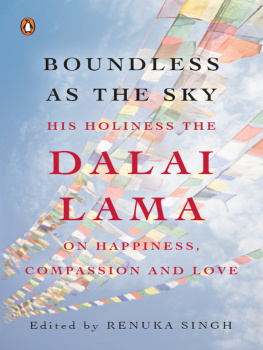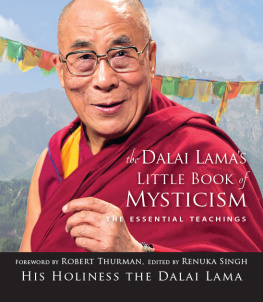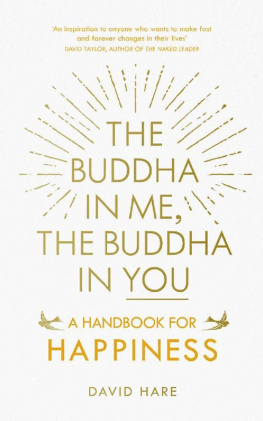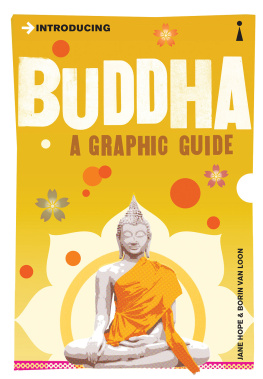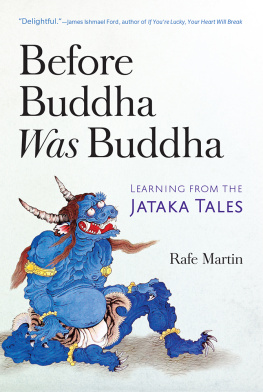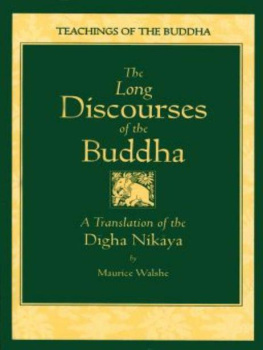Becoming Buddha
Wisdom Culture for a Meaningful Life
Edited by
Renuka Singh

Dedicated to the long lives of our precious teachers
His Holiness the Dalai Lama
and
Ven. Lama Thubten Zopa Rinpoche
May they have stable lives till samsara ends
Foreword
I should begin by recalling how Tushita Mahayana Meditation Centre started. It was in January 1977 at our Kopan Monastery, near Kathmandu, Nepal, that my late teacher, Lama Yeshe, who was also kinder to me than the Buddhas of the past, present and future, first suggested that we start a centre in Delhi. Lama said that he wanted to repay the kindness of the Indian people.
How had the Indian people been kind? Well, leaving aside the fact that according to the Mahayana teachings all sentient beings have been kind, Tibetans identify several particular kindnesses shown to them by India. The most immediate, of course, was that of giving Tibetan refugees a home in 1959, after the occupation of our country by the communist Chinese, and thereafter allowing us the freedom to preserve our culture and practise our religion completely unfettered. This is an enormous kindness not just to Tibetans but to the entire world as well.
More generally, because India is where Lord Buddha lived and taught and is the source of the Buddha Dharma, Tibetans have always held the Land of the Aryas in high esteem. We have also been extremely grateful to India for facilitating the transmission of the Dharma teachings to Tibet, starting in the year 650 CE , by sending teachers to Tibet, training Tibetan scholars in India, and essentially providing the Tibetan script, which is based on Sanskrit and was developed in order to translate Buddhist scriptures into Tibetan. Although we speak of Tibetan Buddhism, the Buddhism of Tibet is essentially Indian Buddhism, especially that which His Holiness the Dalai Lama calls the Nalanda Tradition. In Tibet, for teachings to be accepted as authentic, they had to be shown to have a pure Indian source. Along with Nalanda, the other great Indian monastic universities of Odantapuri and Vikramshila served as the inspiration for the great monastic universities of Tibet.
Buddhism flourished in the land of its origin for some 1500 years, and around the time it reached its zenith in India, the transmission to Tibet began. As a result, the Buddhism that went to Tibet over a period of some five centuries contained all three vehiclesthe Hinayana sutra, the Mahayana sutra (Paramitayana) and tantra (Vajrayana). In Tibet, as Buddhism declined in India and was essentially destroyed, Dharma flourished for a thousand years, until in Tibet too it was largely destroyed by external forces.
Therefore, the main kindness that Lama Yeshe was wanting to repay by establishing Tushita as a teaching and meditation centre, where Indian people could once again study and practise Indian Buddhism as it had been preserved and developed in Tibet, was that of Indias providing Dharma to Tibet in the first place.
In 1959, after the failed uprising against Chinese oppression, His Holiness the Dalai Lama, his two tutors Kyabje Ling Rinpoche and Kyabje Trijang Rinpochemany other high lamas, and one hundred thousand ordinary Tibetans fled for safety to India, bringing with them centuries of learning and experience. Many of them settled in Dharamsala, after the Indian government offered them facilities in that area.
Lama Yeshe himself had a retreat centre there, but when it came to starting a teaching centre for the benefit of Indians, he chose New Delhi, which was where many people resided and was a great crossroad for many teachers and travellers. Accordingly, he sent the Australian monk, Dr Nick Ribush, to India to work with an Indian student, Sunita Kakaria, to establish Tushita in New Delhi. It took them over two years to find a suitable location, but eventually a beautiful house was chosen in the suburb of Shantiniketan, and in the summer of 1979, Tushita Mahayana Meditation Centre opened.
Right from the start, the Centre began inviting some of the greatest Tibetan lamas in exile to teach there and hosted many other Tibetan teachers as well as Indian and Western scholars, offering a full programme of teaching and meditation. Among the lamas who taught there were His Holinesss two tutors, Tsenshab Serkong Rinpoche, HH Song Rinpoche, Geshe Rabten, Geshe Sopa and Geshe Dhargyey. Lama Yeshe also taught there many times and we were very fortunate that Gelek Rinpoche was resident in New Delhi at that time and he was Tushitas most regular teacher for several years.
In 1981, Lama Yeshe invited His Holiness the Dalai Lama to launch what he envisioned would become a regular event, Tushitas Dharma Celebration. Unfortunately, His Holiness was not available that year but the then home minister, former president Giani Zail Singh, accepted Lamas invitation to be the guest of honour at a wonderful event held at Hotel Oberoi. However, the following year His Holiness was able to attend and participate in a teaching event at Hotel Ashoka.
Following many previous directors, Dr Renuka Singh took over the running of Tushita and has ably continued the tradition of regularly inviting His Holiness to preside over these occasions.
Therefore, again, it is my pleasure to invite you to enjoy this book, which contains teachings by some of the teachers who visited Tushita in the early years.
Lama Thubten Zopa Rinpoche
Spiritual Director, Tushita Mahayana Meditation Centre
Introduction
The age of reason vanquished religion whereas our secular age today is starting to see that we need to re-recruit the religious consciousness. It denounces the fetishism of the market and technology, and legitimizes subjective freedom. Our modern malaise produces a depressive scenario and in the post-modernist consumerist era, commodity forms have triumphed. A pragmatic approach reduces everything to quantity and eviscerated identity. Living in a purely materialistic time, people lead sleepy lives instead of being aware and awake.
A widespread sense of ethical disarray, terror and destruction, depletion of natural resources and psychic catastrophes have resulted in a pandemic of suffering, not to forget the human vulnerability to disease, old age and death. While writing about the impossibility of a wholly secure self-identity and/or social structure, D. Whillis talks about the critique of modernity as inducing meaninglessness. as he questions the global dominance of the new religion of money and materialism:
The most urgent and fundamental political problem is to restore to people an insight into the power and freedom of their attention. For a world of excessive mediation, attention is captured by image, spectacle and glamour; if it is demanded by economic necessity; it is reduced by flattery of greed, lust and ambition; it is compelled by fear. Mediation substitutes for singular experience, leaving segmented, isolated and fragmented individuals enclosed by the walls of their own thoughts and desires. All too often, escape from isolation builds collectivity out of violence against difference and singularity. In such a condition, nothing is more needful than the redemption of attention: the discovery of the possibility of turning towards that which matters.
Whereas Buddhism is emerging as a re-enchanting force throughout the world today, the practice of Buddhism flourished long in India and spread to Tibet in the seventh century CE . It has been brought back to India following the tragedy that befell Tibet in the 1950s and the flight of many Tibetans to exile in India. The presences of His Holiness the Dalai Lama and many other precious lamas and teachers have been a spring of inspiration for several generations.


